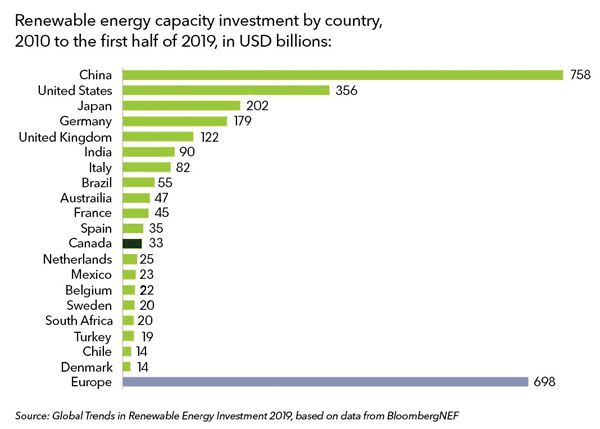London, New York and Frankfurt: The first half of 2019 saw a 39% slowdown in renewable energy investment in the world’s biggest market, China, to $28.8 billion, the lowest figure for any half-year period since 2013, according to figures issued July 10 from BloombergNEF (BNEF).
 The plunge in activity in China, as the country shifts this year away from government-set tariffs to auctions for new wind and solar capacity, also depressed the first half 2019 global investment figure – to $117.6 billion, down 14% compared to the first half of 2018.
The plunge in activity in China, as the country shifts this year away from government-set tariffs to auctions for new wind and solar capacity, also depressed the first half 2019 global investment figure – to $117.6 billion, down 14% compared to the first half of 2018.
On the other hand, according to figures released September 5, global investment in new renewable energy capacity over the entire current decade — 2010 to 2019 inclusive — is on course to hit US$ 2.6 trillion, with more gigawatts of solar power capacity installed than any other generation technology.
According to the Global Trends in Renewable Energy Investment 2019 report, released ahead of the UN Global Climate Action Summit, this investment is set to have roughly quadrupled renewable energy capacity (excluding large hydro) from 414 GW at the end of 2009 to just over 1,650 GW when the decade closes at the end of this year.
Solar power will have drawn half — USD 1.3 trillion — of the USD 2.6 trillion in renewable energy capacity investments made over the decade. Solar alone will have grown from 25 GW at the beginning of 2010 to an expected 663 GW by the close of 2019 — enough to produce all the electricity needed each year by about 100 million average homes in the USA[2].
The global share of electricity generation accounted for by renewables reached 12.9 per cent, in 2018, up from 11.6 per cent in 2017. This avoided an estimated 2 billion tonnes of carbon dioxide emissions last year alone — a substantial saving given global power sector emissions of 13.7 billion tonnes in 2018.
Including all major generating technologies (fossil and zero-carbon), the decade is set to see a net 2,366 GW of power capacity installed, with solar accounting for the largest single share (663 GW), coal second (529 GW), and wind and gas in third and fourth places (487 GW and 438 GW respectively).
The cost-competitiveness of renewables has also risen dramatically over the decade. The levelized cost of electricity (a measure that allows comparison of different methods of electricity generation on a consistent basis) is down 81 per cent for solar photovoltaics since 2009; that for onshore wind is down 46 per cent.
“Investing in renewable energy is investing in a sustainable and profitable future, as the last decade of incredible growth in renewables has shown,” said Inger Andersen, Executive Director of the UN Environment Programme.
“But we cannot afford to be complacent. Global power sector emissions have risen about 10 per cent over this period. It is clear that we need to rapidly step up the pace of the global switch to renewables if we are to meet international climate and development goals.”
The Global Trends in Renewable Energy Investment report is commissioned by the UN Environment Programme in cooperation with Frankfurt School-UNEP Collaborating Centre for Climate & Sustainable Energy Finance and produced in collaboration with BloombergNEF. The report is supported by the German Federal Ministry for the Environment, Nature Conservation, and Nuclear Safety.
